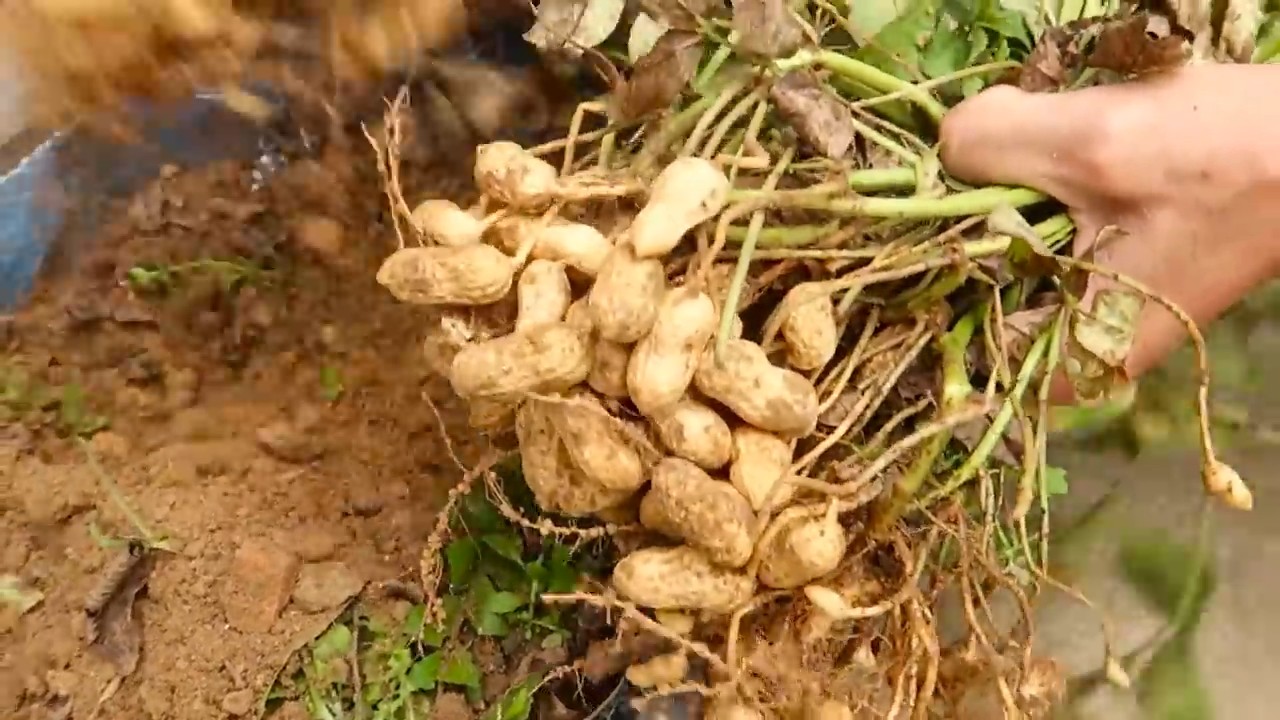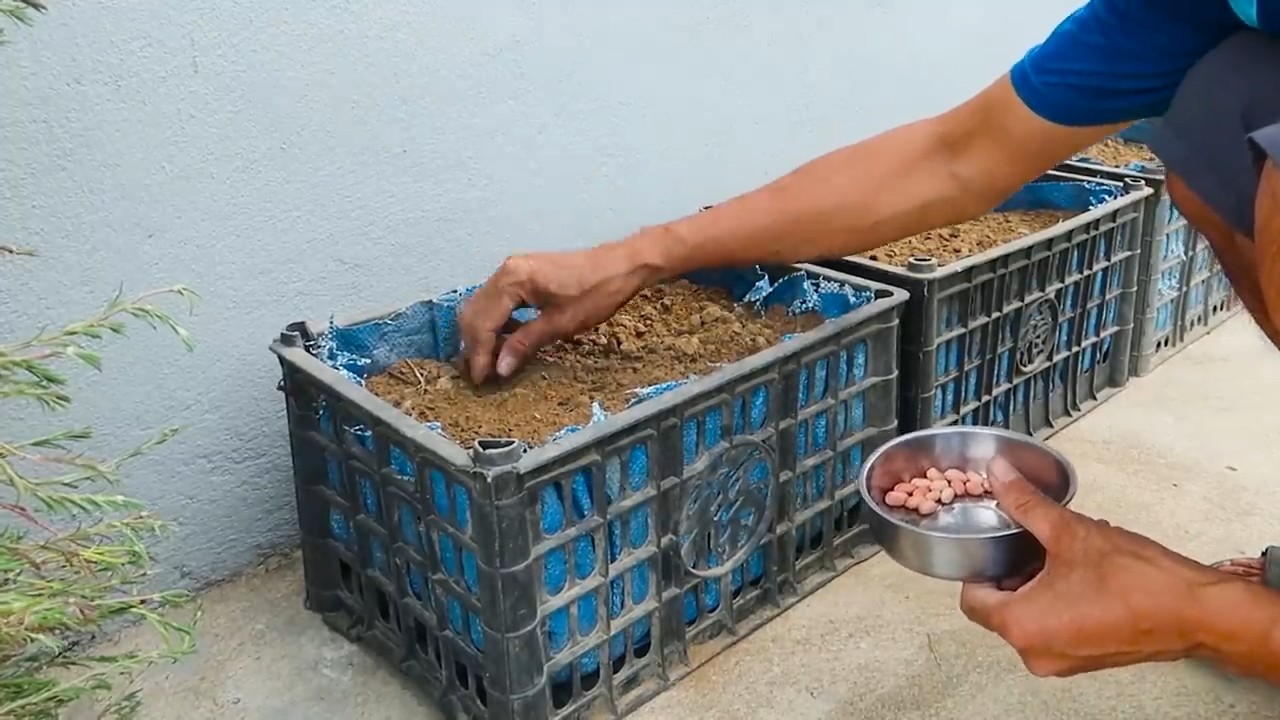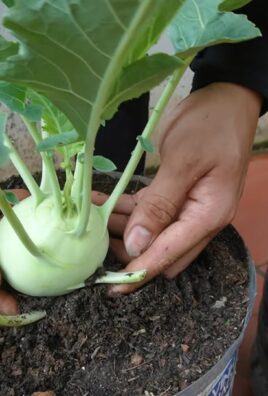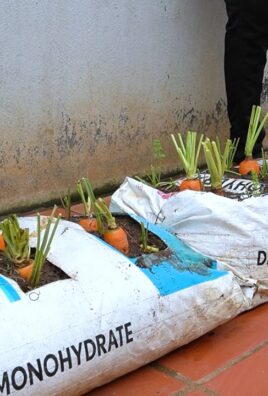Growing peanuts successfully in your own backyard might sound like a daunting task, conjuring images of vast Southern fields and complex agricultural machinery. But I’m here to tell you that with a few clever tricks and a little DIY spirit, you can absolutely cultivate these delicious legumes right in your home garden! Forget the store-bought stuff – imagine the satisfaction of harvesting your own fresh, homegrown peanuts!
Peanuts, also known as groundnuts, have a rich history, dating back thousands of years to South America. They weren’t always a staple of American snacks; their popularity surged in the late 19th and early 20th centuries, thanks in part to the innovative agricultural practices of George Washington Carver. Now, you can continue that legacy in your own small way.
Why bother with the effort? Well, for starters, homegrown peanuts taste incredible – fresher and more flavorful than anything you’ll find on the shelves. Plus, growing peanuts successfully offers a fantastic opportunity to connect with nature, learn about plant life cycles, and enjoy a rewarding, hands-on hobby. In this article, I’ll share some easy-to-follow DIY tricks and hacks that will help you navigate the process, from selecting the right variety to harvesting your bounty. Get ready to dig in and discover the joy of growing your own peanuts!

Growing Peanuts: A Beginner’s Guide to Homegrown Goodness
Hey there, fellow gardening enthusiasts! Ever thought about growing your own peanuts? It might sound a bit daunting, but trust me, it’s a surprisingly rewarding experience. There’s nothing quite like the taste of freshly dug, homegrown peanuts. Plus, it’s a fantastic conversation starter! I’m going to walk you through everything you need to know to successfully grow peanuts in your own backyard.
Choosing the Right Peanut Variety
Before we even get our hands dirty, let’s talk about peanut varieties. Not all peanuts are created equal, and some are better suited for certain climates and growing conditions than others. Here’s a quick rundown of some popular types:
* Virginia Peanuts: These are the large, often roasted peanuts you see in ballparks. They need a longer growing season (120-150 days) and are best suited for warmer climates.
* Spanish Peanuts: These are smaller peanuts with a reddish-brown skin. They have a slightly nutty flavor and are often used in candies and peanut butter. They mature a bit faster than Virginia peanuts (110-130 days).
* Runner Peanuts: These are the most commonly grown type in the United States and are primarily used for peanut butter. They have a uniform size and shape and mature in about 120-140 days.
* Valencia Peanuts: These peanuts have three or more kernels per shell and are known for their sweet flavor. They mature relatively quickly (90-110 days) and are a good choice for cooler climates with shorter growing seasons.
Choosing the right variety for your climate is crucial for success. Check your local extension office or garden center for recommendations on the best varieties for your area. I personally prefer Valencia peanuts because they mature quickly and have a delicious, sweet flavor.
Preparing Your Peanut Patch
Peanuts need a sunny spot with well-drained soil. They don’t like heavy clay soil, so if that’s what you’re working with, you’ll need to amend it. Here’s how I prepare my peanut patch:
* Sunlight: Peanuts need at least 6-8 hours of direct sunlight per day.
* Soil: The ideal soil for peanuts is loose, sandy loam with a pH between 6.0 and 6.5.
* Drainage: Good drainage is essential to prevent root rot.
* Nutrients: Peanuts are legumes, which means they can fix nitrogen from the air. However, they still benefit from a balanced fertilizer.
Step-by-Step Planting Guide
Now for the fun part – planting! Here’s my step-by-step guide to planting peanuts:
1. Prepare the Soil: Start by tilling or turning over the soil to a depth of at least 8-10 inches. Remove any rocks, weeds, or debris.
2. Amend the Soil: If your soil is heavy clay, amend it with compost, peat moss, or sand to improve drainage. I like to add a generous amount of compost to my peanut patch.
3. Fertilize: Apply a balanced fertilizer (e.g., 10-10-10) according to the package directions. Work the fertilizer into the soil.
4. Planting Time: Wait until the soil temperature reaches at least 65°F (18°C) before planting. This is usually a couple of weeks after the last frost.
5. Seed Preparation: You can plant peanuts in the shell or shelled. If planting in the shell, crack the shell slightly to help the seed germinate. Soaking the seeds in water for a few hours before planting can also improve germination rates.
6. Planting Depth and Spacing: Plant the peanuts 1-2 inches deep and 6-8 inches apart in rows that are 2-3 feet apart.
7. Watering: Water the soil thoroughly after planting.
8. Marking Rows: I always mark my rows with stakes or labels so I know where I planted them. It’s easy to forget after a few days!
Caring for Your Peanut Plants
Once your peanut plants are in the ground, it’s important to provide them with the care they need to thrive. Here’s what I do to keep my peanut plants happy and healthy:
* Watering: Water regularly, especially during dry periods. Peanuts need about 1 inch of water per week. Avoid overwatering, as this can lead to root rot.
* Weeding: Keep the area around your peanut plants free of weeds. Weeds compete with peanuts for nutrients and water. I like to hand-pull weeds or use a hoe to cultivate the soil.
* Hilling: As the peanut plants grow, hill the soil around the base of the plants. This helps to support the developing pegs (the stems that grow down into the soil and form the peanuts).
* Fertilizing: Side-dress the plants with a nitrogen-rich fertilizer about 4-6 weeks after planting. This will help to promote healthy growth.
* Pest Control: Peanuts are generally pest-resistant, but they can be susceptible to certain pests, such as aphids and spider mites. Inspect your plants regularly and treat any infestations promptly. I prefer to use organic pest control methods, such as insecticidal soap or neem oil.
Understanding Pegging
One of the most fascinating things about growing peanuts is the way they develop. After the peanut plant flowers, it sends out “pegs” from the base of the flower. These pegs grow down into the soil and develop into peanuts.
Pegging is a critical stage in peanut development. Make sure the soil is loose and moist to allow the pegs to penetrate easily. Hilling the soil around the base of the plants can also help.
Harvesting Your Peanut Crop
Harvesting peanuts is the most rewarding part of the process! Here’s how I know when it’s time to harvest and how I go about it:
1. Timing: The best time to harvest peanuts is when the leaves start to turn yellow and the plants begin to die back. This usually occurs about 120-150 days after planting, depending on the variety.
2. Testing: To check if the peanuts are ready, dig up a few plants and inspect the pods. The pods should be plump and full, and the kernels should be well-developed. The inside of the shell should have a dark veining pattern.
3. Digging: Use a garden fork or shovel to carefully dig up the peanut plants. Be gentle to avoid damaging the pods.
4. Shaking: Shake off any excess soil from the plants.
5. Drying: Hang the plants upside down in a well-ventilated area to dry for 2-3 weeks. This allows the peanuts to cure and develop their flavor. I usually hang them in my garage.
6. Picking: Once the plants are dry, pick the peanuts from the vines.
7. Cleaning: Wash the peanuts with water to remove any remaining soil.
8. Drying (Again!): Spread the peanuts out on a screen or tray to dry completely. This can take several days.
Roasting Your Homegrown Peanuts
Now for the best part – roasting your homegrown peanuts! Here’s my simple roasting method:
1. Preheat Oven: Preheat your oven to 350°F (175°C).
2. Spread Peanuts: Spread the peanuts in a single layer on a baking sheet.
3. Roast: Roast for 20-25 minutes, or until the peanuts are golden brown and fragrant. Stir the peanuts occasionally to ensure even roasting.
4. Cool: Let the peanuts cool completely before storing them in an airtight container.
Freshly roasted peanuts are absolutely delicious! You can enjoy them as a snack, use them in recipes, or make your own peanut butter.
Troubleshooting Common Peanut Problems
Even with the best care, you might encounter some problems when growing peanuts. Here are a few common issues and how to address them:
* Poor Germination: This can be caused by cold soil, poor-quality seeds, or overwatering. Make sure the soil temperature is warm enough before planting, use fresh seeds, and avoid overwatering.
* Yellowing Leaves: This can be a sign of nutrient deficiency or disease. Fertilize the plants with a balanced fertilizer and inspect them for signs of disease.
* Root Rot: This is caused by overwatering or poorly drained soil. Improve drainage and avoid overwatering.
* Pest Infestations: Inspect your plants regularly and treat any infestations promptly with organic pest control methods.
* Empty Pods: This can be caused by poor pollination or nutrient deficiency. Ensure adequate pollination by providing plenty of sunlight and water, and fertilize the plants with a balanced fertilizer.
Storing Your Peanut Harvest

Conclusion
So, there you have it! Growing peanuts successfully at home is not only achievable but also incredibly rewarding. From the initial planting to the satisfying harvest, every step of the process connects you to the earth and provides a unique sense of accomplishment. We’ve walked you through the essential steps, highlighting the importance of well-drained soil, consistent watering, and diligent pest control.
But why is this DIY trick a must-try? Beyond the sheer joy of nurturing life, growing your own peanuts offers several compelling advantages. First and foremost, you have complete control over the growing process. You can choose organic methods, ensuring that your peanuts are free from harmful pesticides and chemicals. This is a significant benefit, especially if you’re health-conscious or have dietary restrictions. Secondly, homegrown peanuts often boast a superior flavor compared to store-bought varieties. The freshness and the care you put into growing them translate into a richer, more nuanced taste. Finally, it’s an educational and engaging activity for the whole family. Children can learn about plant life cycles, the importance of sustainable practices, and the satisfaction of harvesting their own food.
Don’t be afraid to experiment with variations! Try different peanut varieties to discover your favorite flavor profile. Valencia peanuts are known for their sweetness, while Virginia peanuts are prized for their large size. You can also explore different planting methods, such as container gardening, if you have limited space. Consider companion planting with herbs like basil or rosemary, which can help deter pests and enhance the flavor of your peanuts. Another fun variation is to roast your freshly harvested peanuts with different seasonings. A sprinkle of sea salt, a dash of chili powder, or a drizzle of honey can transform your homegrown peanuts into a gourmet snack.
Growing peanuts successfully is more than just a gardening project; it’s an experience. It’s a chance to connect with nature, learn new skills, and enjoy the fruits (or rather, nuts) of your labor. We encourage you to take the plunge and try growing your own peanuts this season. You might be surprised at how easy and enjoyable it is.
Once you’ve harvested your bounty, don’t forget to share your experiences with us! We’d love to hear about your successes, challenges, and any unique tips or tricks you’ve discovered along the way. Share your photos and stories in the comments section below. Let’s build a community of peanut-growing enthusiasts and inspire others to embark on this rewarding journey. Happy growing!
Frequently Asked Questions (FAQ)
What is the best time of year to plant peanuts?
The ideal time to plant peanuts is in the spring, after the last frost has passed and the soil has warmed up to at least 65°F (18°C). Peanuts require a long growing season of at least 120-150 days, so it’s crucial to plant them early enough to allow them to mature fully before the first frost of autumn. In warmer climates, you may be able to plant peanuts slightly earlier, but always check your local weather forecast and soil temperatures to ensure optimal growing conditions. Planting too early in cold soil can lead to poor germination and stunted growth.
How much space do peanuts need to grow?
Peanuts need adequate space to spread their roots and develop their pods. As a general rule, space peanut plants about 6-8 inches apart in rows that are 2-3 feet apart. This spacing allows for proper air circulation and sunlight penetration, which are essential for healthy growth and pod development. If you’re growing peanuts in containers, choose pots that are at least 12 inches in diameter and depth to accommodate the plant’s root system. Overcrowding can lead to smaller yields and increased susceptibility to diseases.
What type of soil is best for growing peanuts?
Peanuts thrive in well-drained, sandy loam soil with a slightly acidic to neutral pH (between 6.0 and 7.0). Sandy loam soil provides good drainage, which is crucial for preventing root rot and other fungal diseases. It also allows the peanut pegs (the stems that develop into pods) to easily penetrate the soil. If your soil is heavy clay, amend it with organic matter such as compost or peat moss to improve drainage and aeration. Avoid planting peanuts in compacted or waterlogged soil, as this can significantly reduce yields.
How often should I water my peanut plants?
Peanut plants need consistent watering, especially during the flowering and pod development stages. Water deeply and regularly, aiming to keep the soil consistently moist but not waterlogged. A good rule of thumb is to water about 1 inch per week, either through rainfall or irrigation. Avoid overhead watering, as this can increase the risk of fungal diseases. Instead, water at the base of the plants to keep the foliage dry. During periods of drought, you may need to water more frequently to prevent the plants from drying out.
What are some common pests and diseases that affect peanut plants?
Peanut plants can be susceptible to various pests and diseases, including aphids, spider mites, leafhoppers, and fungal diseases such as leaf spot and root rot. Regularly inspect your plants for signs of infestation or disease, such as yellowing leaves, stunted growth, or visible pests. To prevent pest and disease problems, practice good garden hygiene, such as removing weeds and debris around the plants. You can also use organic pest control methods, such as insecticidal soap or neem oil, to control aphids and spider mites. For fungal diseases, ensure good air circulation and avoid overwatering. If necessary, you can use a fungicide to treat infected plants.
How do I know when my peanuts are ready to harvest?
The best way to determine when your peanuts are ready to harvest is to check the maturity of the pods. About 120-150 days after planting, dig up a few plants and examine the pods. The pods should be plump and full, with a distinct veining pattern on the shell. The inside of the shell should be dark brown, and the kernels should be fully developed and easily detached from the shell. If the pods are still white or pale, they are not yet mature. Once the majority of the pods are mature, you can harvest the entire crop.
What is the best way to cure peanuts after harvesting?
After harvesting, peanuts need to be properly cured to reduce their moisture content and prevent spoilage. The traditional method is to pull up the entire plant and shake off any excess soil. Then, turn the plants upside down and allow them to dry in the sun for several days, or until the leaves and stems are completely dry and brittle. You can also hang the plants upside down in a well-ventilated area, such as a garage or shed. Once the plants are dry, remove the peanuts from the vines and store them in a cool, dry place. Properly cured peanuts can be stored for several months.
Can I grow peanuts in containers?
Yes, you can successfully grow peanuts in containers, especially if you have limited space. Choose containers that are at least 12 inches in diameter and depth to accommodate the plant’s root system. Use a well-draining potting mix and ensure that the containers have drainage holes. Water regularly and fertilize as needed. Container-grown peanuts may require more frequent watering than those grown in the ground, as the soil in containers tends to dry out more quickly. Place the containers in a sunny location that receives at least 6-8 hours of sunlight per day.
Are there different varieties of peanuts I can grow?
Yes, there are several different varieties of peanuts you can grow, each with its own unique characteristics. Virginia peanuts are known for their large size and are often used for roasting and snacking. Valencia peanuts are smaller and sweeter, and are often used for boiling. Spanish peanuts are small and round, and are often used for peanut butter. Choose a variety that is well-suited to your climate and growing conditions. You can find peanut seeds or seedlings at most garden centers or online retailers.
Can I save seeds from my homegrown peanuts to plant next year?
Yes, you can save seeds from your homegrown peanuts to plant next year, but it’s important to choose the best quality pods for seed saving. Select pods that are fully mature, plump, and free from any signs of disease or damage. Allow the pods to dry completely before storing them in a cool, dry place. When you’re ready to plant next year, crack open the pods and remove the kernels. Soak the kernels in water for a few hours before planting to improve germination rates. Keep in mind that peanuts are self-pollinating, so the seeds you save will generally produce plants that are true to type.





Leave a Comment